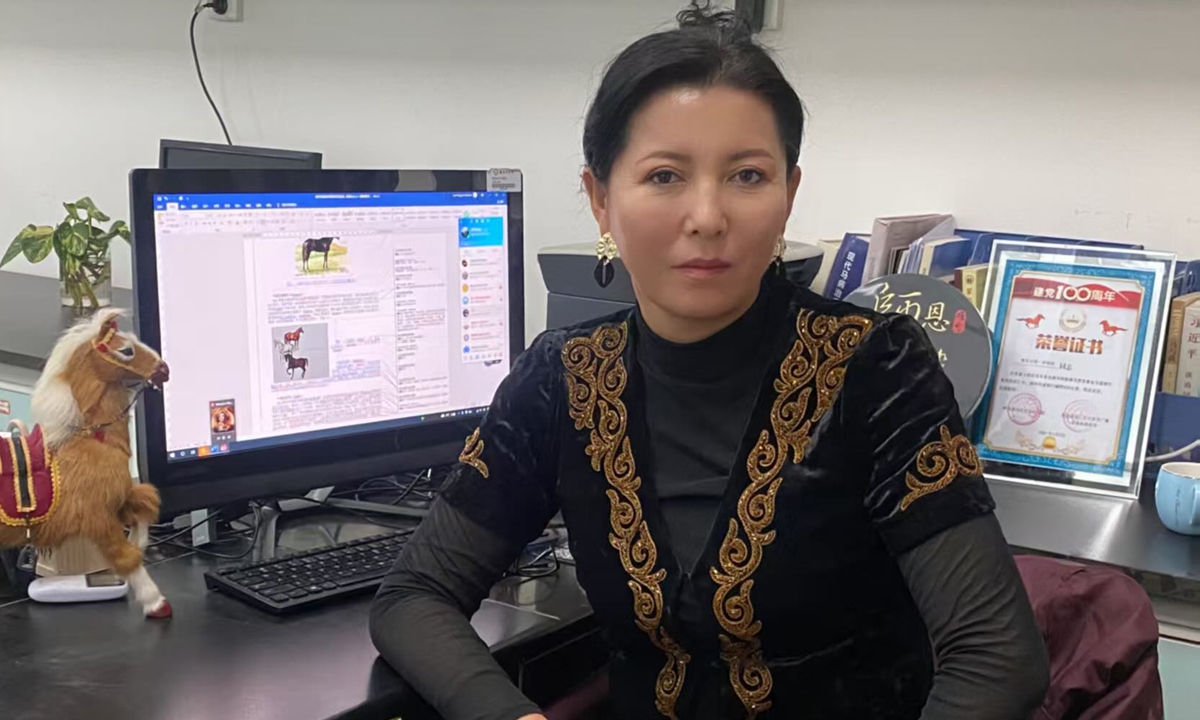来源:环球时报

Professor Gemingguli Muhetai of Tarim University, dresses in Kazakh traditional costume. Photo: Courtesy of Gemingguli
Cooperation between China and Central Asian countries is increasing, especially in the fields of biodiversity research, water resources, crop science, food safety, and modern agriculture. Professor Gemingguli Muhetai of Tarim University, in Northwest China's Xinjiang Uygur Autonomous Region told the Global Times on Monday that Central Asian students are increasingly coming to China to study in fields like molecular biology, agriculture, and veterinary science, with many eager to remain and apply their knowledge to foster deeper cooperation between the two regions.
Gemingguli, a professor at the College of Animal Science and Technology at Tarim University, has long been dedicated to the study of livestock and poultry genetic resources while fostering academic cooperation between China and Central Asia.
Over the years, she has facilitated partnerships between Tarim University, institutions such as China Agricultural University (CAU) and South China Agricultural University (SCAU), and 11 universities and research institutes across Kazakhstan, Uzbekistan, and Kyrgyzstan. These collaborations have led to joint research projects, student recruitment, and faculty exchanges, particularly in agriculture and animal husbandry, benefiting both regions.
According to Gemingguli, efforts of collaboration have led to successful completion of wild plant resource surveys in Kazakhstan and Uzbekistan, with a particular focus on the diversity of Populus euphratica, a species for which Kazakhstan hosts 35 percent of the global resource. The joint China-Kazakh team is actively conducting research on genetic resource protection and development.
In the field of animal resources, Chinese and Kazakh researchers are concentrating on the genetic diversity of equine species. Through molecular breeding techniques, Chinese experts are helping Kazakhstan advance the breeding of dairy and meat horse breeds and protect genetic resources. These technologies are approximately 15 years ahead of Central Asian countries, Gemingguli noted.
Additionally, she mentioned that, in response to Central Asia's shortcomings in the poultry industry, universities such as CAU and SCAU are collaborating with local institutions to promote the protection and independent breeding systems of local poultry breeds, including chickens and ducks.
Based on biodiversity research, she further noted that China-Kazakhstan agricultural cooperation is extending to the downstream segments of the industry chain, with a focus on food development and co-building industry standards. The two countries are working to establish mutually recognized production standards and testing systems for specialty agricultural products, such as mare's milk and meat products, to address trade barriers arising from standard discrepancies in the export of Central Asian organic products to China, she said.
Currently, China and Kazakhstan are also promoting the co-construction of joint laboratories and the development of unified testing methods, she said.
"I am mentoring two PhD students from Central Asia now. They are not only pursuing their studies in specialized fields in China, but also learning Chinese language and culture. After completing their studies, they will be better equipped to serve as bridges for deeper cooperation between China and Central Asia," she said.
According to Gemingguli, Central Asian universities highly value China's scientific capabilities, especially the advanced lab facilities and open knowledge-sharing by Chinese experts. Compared with US and European institutions, China offers more cost-effective and practical technologies, making it a preferred partner in many technical fields.
She noted a clear shift in attitudes. "When I first visited Central Asia in 2004, the perception of China wasn't very positive," she said. "But in the past seven or eight years, that's changed. Younger generations admire China's scientific progress and want to apply it in their own countries."
Looking ahead, she sees strong potential for deeper cooperation—such as building joint laboratories, training technical teams, and exchanging technologies in areas like organic food processing. "It's about mutual benefit," she added.
新闻链接:https://enapp.globaltimes.cn/article/1336287
